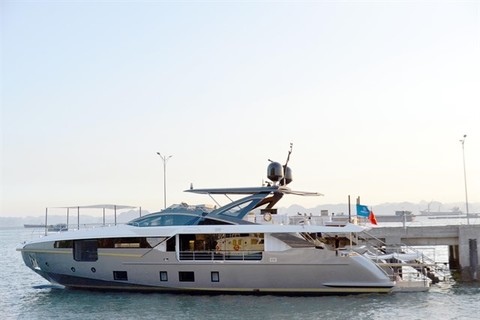Việt Nam to develop yachts services as a signature tourism product
Việt Nam to develop yachts services as a signature tourism product
The Ministry of Transport recently released a draft decision approving the proposal for a yacht management project, which is set to be developed into a signature tourism service of the country by 2030.

The Azimut Grande 32 METRI, a VNĐ600 billion (US$23.6 million) superyacht imported from Italy by a local tourism company, arrives in Hạ Long Bay, Quảng Ninh Province on November 16. The Ministry of Transport aims to expand cooperation with international investors to provide high-quality yacht services to the region and the world. — VNA/VNS Photo Thanh Vân |
The proposal was written by a team of 41 members, led by Hoàng Hồng Giang, deputy director of the Vietnam Maritime Administration.
According to the proposal, the ministry will expand cooperation and joint ventures with international investors and brands to produce and supply high-quality, high-tech yachts, as well as to offer yachting services to the region and the world.
By the end of this year, the ministry will have reviewed and supplemented regulations on yacht management and develop a pilot scheme for managing operations.
This includes regulations on activity zones, docking areas for yachts, responsibilities of ship owners, crew members, captains, and passengers in yacht operations, as well as requirements for the boats operating in port waters and areas managed by maritime authorities.
From 2025 to 2030, the ministry will focus on institutional reforms in seven key areas of work.
It will add a definition of yachts in the Vietnamese Maritime Code and the Inland Waterway Traffic Law, develop a decree regulating the management of yacht operations in both maritime and inland waterways sectors and review the planning of ports and docking areas.
It will also identify maritime areas and inland waterways where yachts with Vietnamese or foreign flags are allowed to operate, develop mechanisms and policies to encourage investment in the yacht industry and related services, and add regulations on yacht port management and related service fees.
Finally, the ministry will consider reducing administrative procedures to ensure seamless entry and departure for yachts at seaports.
According to Nguyễn Mạnh Hùng, deputy chief executive officer of Ana Marina Nha Trang Joint Stock Company, Việt Nam's yachts industry is still in its infancy.
Yachts began being imported into Việt Nam by a few individuals in 2007-08 but it was not until 2017 that Vietyatch – the country's first official yacht distributor – was established, Hùng said.
"Now there are about ten companies distributing genuine yachts in Việt Nam, representing more than 40 brands," he said.
"The country has about 200 yachts in total, both old and new, including those that meet international standards. This number is too small compared to the region, the world and the potential of the industry.”
Learning from other countries

A tourist yacht cruises the Saigon River in HCM City. — VNA/VNS Photo Hồng Đạt |
Commenting on the proposal, Lưu Văn Đức, chief executive officer of Lưu Gia Shipbuilding Company Limited, said that the port planning was in time to stimulate yacht tourism development.
While this type of tourism has significant potential, coordinated and continuous efforts are needed to create a favourable environment for its growth, he said.
“Yacht registration procedures should be similar to those currently applied to cars,” Đức said.
Nguyễn Mạnh Hùng from Ana Marina Nha Trang said that to attract international yachts to Việt Nam, the proposal should outline a roadmap and solutions to address discrepancies between Việt Nam’s and international yacht regulations and practices.
“International yacht management, including yacht classification and registration, should be studied carefully,” he said.
For example, in Hongkong (China), yacht operations are managed based on the results of inspections and the ship owner's needs, with certificates of ownership and operating licences issued for limited periods, according to Hùng.
In Singapore, yachts wishing to operate domestically are only granted operational licences, not registration certificates, while yachts wishing to travel internationally are granted registration certificates, he added.
“There should also be further studies on international standards for crew qualifications and staffing levels,” Hùng said.
For short-term management, he recommended the transport ministry to review, adjust regulations on yacht registration, inspections, crew qualifications and simplify certain administrative procedures.
For long-term solutions, the ministry should build a comprehensive legal framework that aligns Việt Nam’s yacht industry with international practices to attract domestic and foreign investment, he said.























